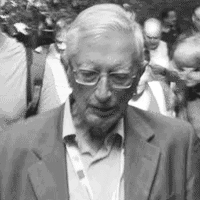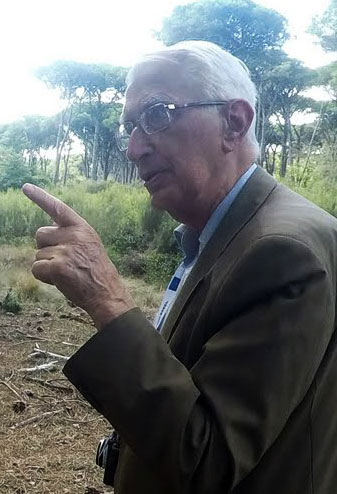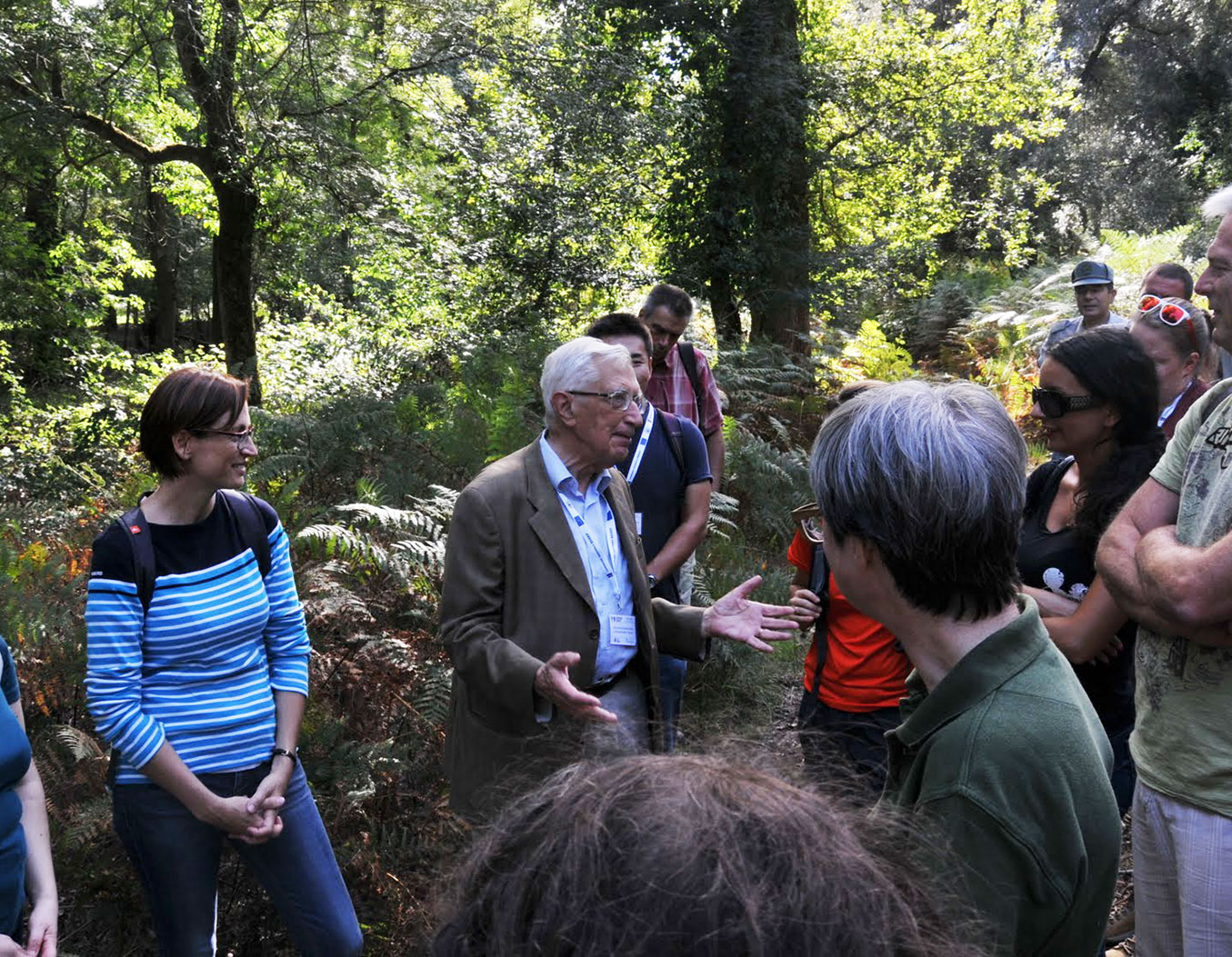
Obituary: Ervedo Giordano, silviculturalist and forest ecologist from the Mediterranean, open to the world and to international forestry
iForest - Biogeosciences and Forestry, Volume 14, Issue 3, Pages 221-223 (2021)
doi: https://doi.org/10.3832/ifor0060-014
Published: May 05, 2021 - Copyright © 2021 SISEF
Editorials
Abstract
Ervedo Giordano passed away in Rome on April 24, 2021. This note describes some of his major scientific contributions to research in silviculture and forest ecology, and sketches out the remarkable personality and character traits that he displayed throughout his life.
Keywords
Ervedo Giordano (born Bra-Cuneo Sep 20, 1930, died Rome Apr 24, 2021) was a widely known silviculturalist and forest ecologist, who spent most of his research activity experimenting on plantation forestry and organizing vast tree breeding programs for poplars, eucalypts and other tree species, with large tree germplasm collections from their native regions in North America, Australia and the Mediterranean basin.
Style, curiosity, and sense of humour, these are the traits that immediately come to mind when remembering him (Fig. 1). Ervedo Giordano was born in Piedmont, in northern Italy, but his family moved frequently throughout Italy, as his father was a high-ranking officer of the Carabinieri corps. In fact, the name chosen for him by his father was an anagram of the word “dovere”, duty in Italian; Ervedo always complied, throughout his life, to the significance of his name, but with amiability and savoir faire.
Ervedo Giordano started his graduate student career in an original way: for his Master degree in Forestry, earned at the University of Florence in 1952, he prepared two Master theses, one with Prof. Alessandro De Philippis on the ecology of Mediterranean forests and the other with Prof. Ezio Magini on the genetics of Mediterranean pines. Undoubtedly, the choice of these two mentors could not be better: first of all because De Philippis and Magini were and remain two Maestri of Forest Science, not only in Italy; but also because Giordano’s relationships with both of them would be solid and fruitful in the years to come. The academic career of Ervedo continued through the Habilitation (with the corresponding title of libero docente, free docent) in Silvics, earned in 1962, and in Forest Ecology and Silviculture, in 1971.
However, his research career started as early as 1954 when Ervedo became research associate at the newly formed Agricultural and Forestry Experimental Center (CSAF) which his mentor, prof. De Philippis, had just founded in Rome with the financial support of the National Agency for Pulp and Paper (ENCC), organization that was already operating the renowned Poplar Culture Institute of Casale Monferrato, in northern Italy. The challenge was to promote the development of forest planting and landscape restoration programs in the Mediterranean environment of central-southern Italy, based on solid scientific foundations, an absolutely sound motivation still valid today in the bio-ecological field. Giordano’s research activity developed rapidly within the CSAF, in the specific sectors of Silviculture, Ecology and Forest Genetics, where after few years he became senior researcher. His scientific interests included the fast-growing tree species of considerable importance for the Mediterranean environment, such as eucalypts, radiata pine and poplars; however, other important forest trees for the southern regions of Italy were not neglected, such as the Mediterranean pines, Aleppo pine, maritime pine and stone pine. Research activities were always initiated by elucidating and understanding some of the basic scientific problems such as the evaluation of the native germplasm of those forest tree species, the ecological responses of natural tree populations, as well as some biological features of that plant material; then, at a later stage, also applicative aspects related to plant reproduction, hybridization, vegetative propagation and nursery production were considered. This approach was absolutely advanced at that time while at the base of present-day concept of sustainable forestry, that is forest management based on solid and continuously renewed scientific knowledge. But, on a closer inspection, even the concepts of forest germplasm collections and of tree natural populations, as fundamental sources of genetic and functional diversity, are concepts currently well-known and diffusely utilized today, but very modern and innovative in those early years.
That’s why Giordano organized long field campaigns in Australia for collecting precious seed sources of various species of eucalypts (Eucalyptus camaldulensis, E. globulus, E. occidentalis, E. viminalis, E. gunnii and more species); then he experimented on the reproduction and hybridization of eucalypt trees, while testing the effects of growth regulating substances (so-called phytohormones) on their vegetative propagation. Eventually, those experiments found useful applications to the cultivation and production of Eucalypt plantations in central and southern Italy, in other Mediterranean countries and also in Latin America. Also, at the end of the 1950s, Giordano developed a similar approach for poplars, particularly for the natural populations of Populus deltoides, along the Mississippi river, in the USA; and together with his colleague and friend, the forest geneticist Enzo Avanzo, he organized the collection of P. tremula seeds and cuttings in the interior and mountain areas from all over Italy. The whole Cottonwood study program was based on collecting, planting and then evaluating the P. deltoides genetic material from very different environments in North America, from the State of Mississippi to Iowa and from Texas and Oklahoma to Illinois; therefore, it enabled a decisive leap forward for the research activities and competences in Italy, in the field of poplar genetics, breeding and cultivation. This research program, conceived and implemented by Ervedo Giordano, subsequently made possible to ENCC scientists, and here again the connection with E. Avanzo was particularly effective, to select very promising and advanced reproductive materials and clones, well adapted to various countries of the Mediterranean basin, not only for Italy. This vast poplar research program included also other Italian native species, potentially important for the internal regions of the country, such as Aspen and white poplar. Likewise, this research effort holds merit still today and should be revamped and strengthened, especially now that poplars assume considerable value worldwide; this is true not only for their enormous potential for cultivation but also because, thanks to the advanced knowledge of their genome, they offer to forest research the most important model tree to “hook up” a large number of basic biological and functional studies, whose value we are not yet able to quantify.
Other tree species experimented upon by Giordano in the ’60s and ’70s of last century, in terms of ecological responses, production and genetic diversity, were the Mediterranean pines and the Radiata pine, without forgetting useful in-depth applications on the conservation, treatment and germination of seeds, on the nursery breeding techniques, on the management and productivity of forest plantations in central and southern Italy and in the countries of North Africa. Moreover, some researches conducted by Giordano on the root systems of adult trees of E. globulus, P. radiata and Populus spp., on the vegetative propagation of Radiata pine, and on the effect of phytohormones on eucalypts, are still quite modern and absolutely valid even today. Also, an absolutely innovative initiative was taken with the establishment, in a ENCC Experimental Farm near Rome, of the largest ex situ collection of Poplar germplasm suitable for the Mediterranean environment, the so-called Populetum mediterraneum, planted starting from the year 1961.
The ENCC-CSAF Center of Casalotti (Rome), where Ervedo first became research coordinator and, then, Director until 1975, quickly reached an authoritative role in national and international forestry research, thanks to the innovative researches conducted by Giordano and his colleagues and thanks to a wide and far-sighted availability of financial means, structures and, above all, technical and research personnel. Several international congresses and meetings took place at that Center over a period of 20-25 years, in cooperation with renowned international research organizations and networks, as the International Union of Forest Research Organizations, the International Poplar Commission and Silva Mediterranea of FAO, and the World Eucalyptus Network; also, advanced courses, training courses and summer schools were held at CSAF with the participation of several scientists, experts and graduate students from all over the world.
In 1973, one of the first Chinese delegations visiting the Western countries, which included the Chinese vice-Minister of Forestry, was welcomed at CSAF Center by De Philippis and Giordano; eventually, the Chinese officials came back to China with bunches of poplar cuttings of Italian clones which found a large planting success in China, as nowadays those Italian clones cover some million hectares in that vast country, a much larger surface than the today’s poplar land cover all over Italy. Looking backward, it is surprising to note that within a few years after the end of a devastating World War that ravaged Europe and our country, Italian forestry research had the opportunity to reach a prominent position within the international arena, in studies concerning tree genetic diversity, forest ecology, forest landscape restoration and forest plantations for the Mediterranean environment; and this was for a great amount merit of Ervedo Giordano and his forest co-workers and colleagues. This international dimension was also well represented by the organizational positions held by Ervedo: in 1962 Giordano was appointed as Technical Secretary of the FAO Mediterranean Forestry Research Coordination Committee, enhancing international activities such as the implementation of nine research projects, involving several countries as France, Spain, Morocco, Tunisia, Israel, Turkey, Greece and Yugoslavia. In 1976 he was called to be part of the IUFRO Executive Committee, and as Head of the countries of the Mediterranean region, he participated to the activities of the FAO Silva Mediterranea Commission; also, he was elected to the post of President of FAO’s International Poplar Commission, starting in 1975.
But Ervedo Giordano was not a person to stay too long in a given place nor on a single working activity: after cultivating an intense academic and teaching collaboration, over about ten years, with the University of Florence, in 1975 he became full professor of Forest Ecology and Silviculture at the newly founded Forestry curriculum of the University of Bari, where he created the Institute of Silviculture, the first in southern Italy, at that time. The Institute, directed by Ervedo, became the reference point for many Forestry students and also for officers of the Italian Forest Service, from all over the South; in fact, those officers who had the degree in Agronomy or Engineering and wished to earn also the Forestry degree, were encouraged to take those courses on Forest Ecology, Silviculture, Watershed and Forest Management taught by Giordano and his colleagues.
With the train, as he arrived in Bari, Ervedo Giordano left, in 1981, to start a new endeavour in Viterbo, an old city just North of Rome. There, he established the new Forestry Science Course within the Faculty of Agriculture, of the recently born University of Tuscia, where he also became Dean for the successive 10 years. He developed also special relationships with the Forestry Department of FAO, the UN organization based in Rome; thanks to this collaboration in the 1990’s a large Forestry Education Conference was organized by FAO, in Rome and Viterbo. Moreover, Giordano promoted the creation of a new Research Institute, the Institute for AgroForestry of the National Research Council, where he was President for many years, and of the Alpine Study Center, of the University of Tuscia, in Pieve Tesino (Trentino, Northern Italy) for training the Forestry students in the Alpine forest environment and to develop research activities in those forest ecosystems. The late Ervedo Giordano was also very much proud for his role of forest expert within the Scientific and Management Committee supervising the Forest Estate of Castelporziano of the President of the Republic of Italy, a large and wonderful Natural Reserve of Mediterranean forest, near Rome. Ervedo was also member of the most important Agriculture and Forest Academies of Italy and in 1996 he contributed to the foundation of the Italian Society of Silviculture and Forest Ecology.
Ervedo Giordano has really practiced and taught, to several generations of forest scholars, a true passion for research, for scientific investigation on which to base a solid knowledge for subsequent applications to management, and a true love for trees and forest ecosystems (Fig. 2); he also greatly promoted, throughout his life, vast networks of international relationships and collaborations in forest research and education, as he was deeply convinced of the extraordinary scientific and also human value of cooperating, comparing and cross-validating research activities across countries, regions and cultures of the world, for the advantage of scientific institutions, for the advancement of forest management and conservation and for the education of young scholars and practitioners worldwide. However, the most important lesson by Ervedo learned by his students and colleagues is about combining scientific curiosity, intellectual fun and the ability to work together, among different people, structures, institutions: forestry issues are too broad and our means too modest to be able to tackle them alone.
Fig. 2 - Ervedo Giordano talking to young researchers and scholars in the natural reserve of San Rossore (Pisa, Italy).
Authors’ Info
Authors’ Affiliation
Department of Innovation in Biological, Agro-food and Forest Systems, University of Tuscia, v. San Camillo de’ Lellis snc, I-01100 Viterbo (Italy)
Corresponding author
Paper Info
Citation
Scarascia Mugnozza G (2021). Obituary: Ervedo Giordano, silviculturalist and forest ecologist from the Mediterranean, open to the world and to international forestry. iForest 14: 221-223. - doi: 10.3832/ifor0060-014
Academic Editor
Gabriele Bucci
Paper history
Received: Apr 29, 2021
Accepted: May 02, 2021
First online: May 05, 2021
Publication Date: Jun 30, 2021
Publication Time: 0.10 months
Copyright Information
© SISEF - The Italian Society of Silviculture and Forest Ecology 2021
Open Access
This article is distributed under the terms of the Creative Commons Attribution-Non Commercial 4.0 International (https://creativecommons.org/licenses/by-nc/4.0/), which permits unrestricted use, distribution, and reproduction in any medium, provided you give appropriate credit to the original author(s) and the source, provide a link to the Creative Commons license, and indicate if changes were made.
Web Metrics
Breakdown by View Type
Article Usage
Total Article Views: 33050
(from publication date up to now)
Breakdown by View Type
HTML Page Views: 28662
Abstract Page Views: 1907
PDF Downloads: 1926
Citation/Reference Downloads: 0
XML Downloads: 555
Web Metrics
Days since publication: 1683
Overall contacts: 33050
Avg. contacts per week: 137.46
Article Citations
Article citations are based on data periodically collected from the Clarivate Web of Science web site
(last update: Mar 2025)
(No citations were found up to date. Please come back later)
Publication Metrics
by Dimensions ©
Articles citing this article
List of the papers citing this article based on CrossRef Cited-by.
Related Contents
iForest Similar Articles
Editorials
SISEF and Italian forest science: thirty years of shared progress
vol. 18, pp. 194-196 (online: 05 July 2025)
Review Papers
Structure and management of beech (Fagus sylvatica L.) forests in Italy
vol. 2, pp. 105-113 (online: 10 June 2009)
Research Articles
Tree-oriented silviculture: a new approach for coppice stands
vol. 9, pp. 791-800 (online: 04 August 2016)
Review Papers
Should the silviculture of Aleppo pine (Pinus halepensis Mill.) stands in northern Africa be oriented towards wood or seed and cone production? Diagnosis and current potentiality
vol. 12, pp. 297-305 (online: 27 May 2019)
Research Articles
Public perceptions of forests across Italy: an exploratory national survey
vol. 13, pp. 323-328 (online: 28 July 2020)
Research Articles
Optimizing silviculture in mixed uneven-aged forests to increase the recruitment of browse-sensitive tree species without intervening in ungulate population
vol. 11, pp. 227-236 (online: 12 March 2018)
Review Papers
Opportunities for coppice management at the landscape level: the Italian experience
vol. 9, pp. 775-782 (online: 04 August 2016)
Research Articles
Classification and mapping of Spanish Mediterranean mixed forests
vol. 12, pp. 480-487 (online: 14 October 2019)
Review Papers
Climate change impacts on spatial distribution, tree-ring growth, and water use of stone pine (Pinus pinea L.) forests in the Mediterranean region and silvicultural practices to limit those impacts
vol. 14, pp. 104-112 (online: 01 March 2021)
Research Articles
Forest growth and climate change: evidences from the ICP-Forests intensive monitoring in Italy
vol. 4, pp. 262-267 (online: 13 December 2011)
iForest Database Search
Search By Author
Search By Keyword
Google Scholar Search
Citing Articles
Search By Author
Search By Keywords
PubMed Search
Search By Author
Search By Keyword










